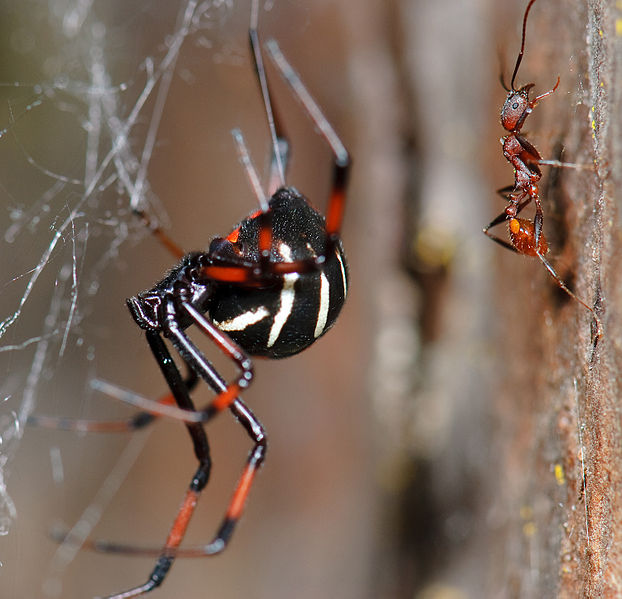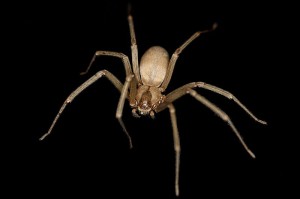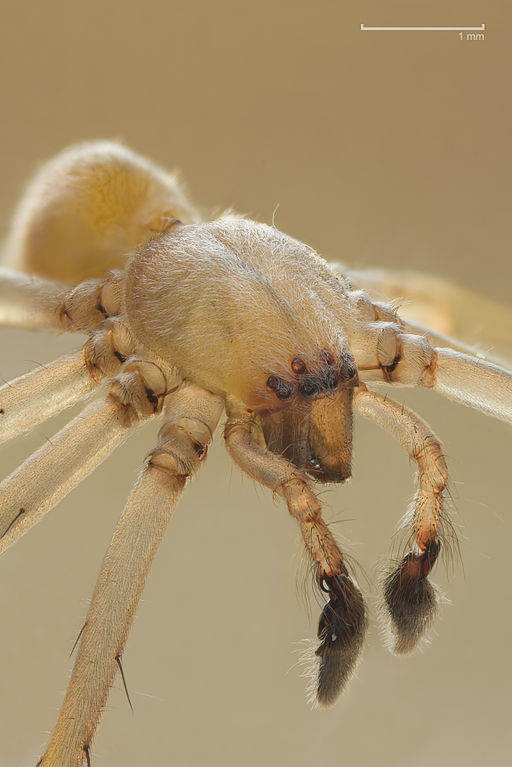Spiders: dangerous enough without lighting yourself on fire
Spiders can be dangerous, but mostly in ways you would never imagine.

New York’s lone native poisonous spider: Latrodectus variolus, the Northern Black Widow. Photo: Marshal Hedin, Creative Commons, some rights reserved
A couple of years ago a guy in Seattle burned his house down trying to kill spiders with a blowtorch. In 2015 at a Michigan gas station, a man tried to kill one with a lighter and burned up a pump island, narrowly escaping injury. And Mazda had to recall 42,000 vehicles in 2014 because spiders could clog a small fuel vent line with silk, potentially cracking the gas tank and causing a fire. It’s no wonder we are afraid of spiders, right?
Fear of spiders is so common and widespread, it may well be encoded in our DNA. Obviously it would have behooved early humans to learn to be wary of spiders, as a few species are poisonous. Mind you, it’s a tiny minority, but spiders can be hard to tell apart. If something with way too many legs and eyes scurries up our leg, most of us will swat first and ask questions later. It’s a rare person whose first reaction is “Great—hand it over so I can key it out!” when their partner announces there’s a big spider in the bed. You know that person is a hardcore nerd. And that they probably have a relationship issue to work out if they don’t want to sleep alone that night.
Worldwide, about 35,000 species of spiders have been identified and named, although there are undoubtedly many more kinds out there running around without a fancy Latin label stuck to them. Roughly 3,000 species call North America home, and of them, only about a dozen are poisonous. New York is host to only one species of toxic spider, while Texas has collected eleven, almost the whole set. But then, they do everything in a big way down there.
Sources don’t agree exactly, but apparently we have close to thirty different species of spiders in the Empire State, with eleven of those considered “common.” You’d think that in higher latitudes we might be exempt from poisonous spiders; after all, most of them live in hot places. But as it happens the lone species of concern in New York, the northern black widow (Latrodectus variolus), is just as happy in the Adirondack and northern tier regions as it is in Long Island.
An interesting sidebar about black widows—so called because they are known to eat the male after mating—is that such behavior is not as common as was once thought. This “sexual cannibalism” (an actual scientific term) was first seen in the lab where males couldn’t get away. Seems that in the wild they adhere to a “best defense is a running head start” school of thought, and most of them survive.
A red and black color scheme on a car is cool. On a spider it’s scary. Lucky for us, to identify the northern black widow we don’t have to flip her upside down to look for the characteristic red hourglass shape on her abdomen. The way I figure it, most bites probably result from people trying to find out if that shiny black spider is poisonous or not. Anyway, the northern species has plenty of bright red geometric patches on her backside in addition to the mark on her belly.

The sometimes deadly brown recluse is not native to New York, but a few hitchhike their way here in vehicles or shipments each year. Photo: Rosa Pineda Creative Commons, some rights reserved
Although black widows have the most toxic venom, the brown recluse spider (Loxosceles reclusa) is more dangerous. Brown recluse bites, while rare, often require medical intervention because they cause significant tissue death (necrosis) with potential infection and scarring. In about one percent of cases, their bites lead to death if the venom becomes systemic. Most of these situations involve the elderly or small children.
Here in New York we have no resident brown recluse spiders, which are found from coast to coast but are concentrated in the Midwest. Their range extends from the Gulf States as far north as Virginia (apparently they have good border controls there). Every year, though, a few end up here when they stow away in luggage or gear of returning vacationers. Brown recluses are tan and shiny, not hairy. They have a darker violin-shaped mark on their backs, with the neck of the violin pointing backwards toward the abdomen.
There are aggressive spiders—the invasive hobo spider in the Pacific Northwest, for example—but it should be noted that all of our poisonous ones are docile. Black widows prefer to run away, and the brown recluse (and other recluse spiders) are named that for a reason. It’s those unfortunate situations when they hide in a bath towel or clothing and become pinned against human skin that lead to bites.

The yellow sac spider is a native, and an aggressive biter, but is only mildly toxic. Photo: Richard Bartz, Creative Commons, some rights reserved
So how come mystery bites are so often blamed on spiders when most species are not even capable of puncturing human skin? First of all, it is unusual that a victim of a “spider bite” actually saw the culprit. If someone wakes up with a red mark it must have been a spider, right?
To be fair, though, we do have a native spider that can and will bite. Yellow sac spiders (Cheiracanthium spp.), common across North America, are ghostly pale, yellow to greenish (sometimes pink or tan), medium-size critters that make little silk homes in curled-up leaves, rock crevices, and occasionally in the corner of a room or in a fuel vent line.
They have a mildly toxic venom that may cause a rash, or in some cases limited tissue necrosis. About twenty-five years ago a yellow sac spider bit the side of my neck (it was in my shirt collar), and an open wound slightly larger than a quarter developed. The lesion turned an alarming gray color and took a couple months to heal. I have to count my blessings, though. There was no fire.
Paul Hetzler is a horticulture and natural resources educator with Cornell Cooperative Extension of St. Lawrence County.
Tags: nature, poisonous insects, spiders








As a person who much prefers the presence of spiders in my abode and barns to that of let’s say mosquitoes I have been known to shock and terrify guests and acquaintances who lay eyes upon my spiders and suggest a desire to kill or attempt to kill them when I prevent them from doing so. To add a bit of hysteria to the spider killer’s grasp on reality I have, in their presence, also been known to gently pet those spiders which do not scurry away at my approach.
To those who maintain that a spider bit them in their sleep, I ask “for what logical reason would a spider bite you?” “Do you think a spider is attempting to kill you so it can cocoon you, drag you off and invite his/her friends to stop by and dine on your liquefying carcass for the next 1000 years?”